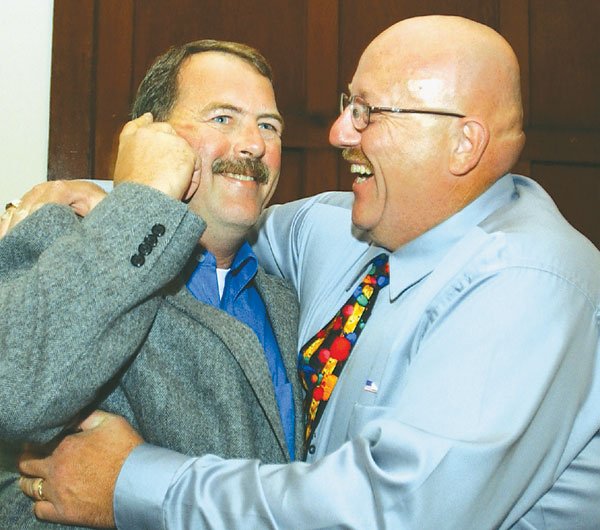GILROY
– It’s not every night that a politician wins an election and a
bride, but on Tuesday night Gilroy native and incumbent City
Councilman Roland Velasco did precisely that.
GILROY – It’s not every night that a politician wins an election and a bride, but on Tuesday night Gilroy native and incumbent City Councilman Roland Velasco did precisely that.
In a tight City Council election, Velasco led all hopefuls with more than 19 percent of the vote. And, after the vast majority of precincts had reported results and a victory looked certain for Velasco, the 37-year-old policy aide for county Supervisor Don Gage proposed to his fiancée Elena Burn, a social worker and resident of Gilroy.
“My personal life had been put on hold for a few months,” Velasco said. “I promised her that we’d talk about marriage as soon as the election was over.”
By the time 90 percent of the vote came in, the talk became a question. Velasco, in his recently purchased Partridge Drive home and in front of dozens of local supporters, asked Burn to marry him.
She said yes.
“I’m very happy that my fiancée said ‘yes.’ I’m also pleased Gilroy voters said ‘yes,’ ” Velasco said. “This is a very good night.”
It was a good night for Russ Valiquette and Paul Correa, too. The two men won seats on a City Council dais both vied for unsuccessfully in 2001.
Valiquette finished in second place with 2,061 votes and Correa placed third with 1,990, just 74 votes ahead of candidate Dion Bracco, who led most of the night.
In a race that had labor unions pushing a slate of four City Council candidates – Correa, Peter Arellano, Mark Dover and Bruce Morasca – only one candidate landed on the dais. Union involvement in this election hit a crescendo weeks ago when it was discovered that a local get-out-the-vote group called Gilroy First! had closer union ties than it had let on.
As a self-entitled voter education group Gilroy First! said it would not endorse candidates. It didn’t, but the unions which hosted the group’s meetings and created its now defunct Web site – all at no cost – did.
The South Bay AFL-CIO endorsed three candidates who were Gilroy First! members – Correa, Peter Arellano and mayoral candidate Lupe Arellano. Both Arellanos lost their election bids.
“This sends a very clear message that money and influence of special interest groups doesn’t buy votes in Gilroy,” Velasco said.
Velasco raised $19,000 of mostly local money to run his campaign – the largest sum of any non-mayoral candidate.
“I had to raise the amount of money I did because I didn’t have the luxury of campaign pieces paid for by unions,” Velasco said.
For Valiquette, spending two years on the city’s Planning Commission helped land him a Council seat, he said.
“Voters definitely got to know who I was,” said Valiquette, who had lost two prior City Council elections. “It’s name recognition, but people saw the work I’ve been doing the last two years, and I think that has helped.”
Incumbent candidate Arellano finished in fifth place, 15 votes behind Bracco. The Kaiser Permanente medical doctor didn’t have much time to digest the loss but indicated that local newspaper coverage played a role in his defeat.
“I think I lost on how I voted (on issues that came before the Council),” Arellano said. “Unfortunately, people read The Dispatch, and The Dispatch wasn’t very nice.”
Arellano said The Dispatch’s coverage on the controversial medical clinic proposed for downtown hurt him.
“Every time they mentioned the clinic downtown, they called it a low-income clinic. It’s a medical clinic,” Arellano said.
For Correa, his victory is bittersweet. The native Gilroyan and professional land-use planner was happy voters elected him. However, he said the city is taking one step forward and one step back by electing him and not re-electing Arellano.
Correa blamed low voter turnout for the loss.
“The low voter turnout killed us,” Correa said. “I’m very disappointed about that.”
Official voter turnout figures will not be available for some time, but all reports indicate it was dismal.
At South Valley Middle School, the precinct closed with 22 percent of those registered voting in person, and an additional 9 percent casting absentee ballots – a total 31 percent turnout.
South Valley poll inspector Ken Sherfy characterized turnout as “poor” but added it had picked up late in the day. According to poll clerk Luis Molina, some voters were confused because they couldn’t necessarily vote where they voted in October’s gubernatorial recall election.
Polling places were added for the recall election due to high expected turnout.
At the polling station in Ruby Hart’s Redwood Lane garage, clerks saw 19 percent of the voters registered for their precinct vote in person. While that turnout figure was sub par, poll workers said voters turned in a higher-than-usual number of absentee ballots although firm figures were not available before deadline.
In the 2001 election, 27.4 percent of registered Gilroy voters cast ballots. In the past 10 years, voter turnout has never exceeded 41 percent for city elections.
For Bracco, who finished just out of the running despite having no prior political experience, the run was encouraging. He credited his success to delivering a clear message to Gilroyans.
“I think Gilroy sees me as a true voice of the people,” the tow-truck business owner said. “I have no hidden agenda, and I’m not interested in anything else but making Gilroy a better place to live.”
For sixth-place finisher Mark Dover, the controversy over the legality of his candidacy was a negative impact to his no-frills campaign that garnered him nearly 11 percent of the vote.
Just days before the election, Mayor Tom Springer directed the city attorney to issue an opinion regarding whether Dover could be on the City Council and keep his current Gavilan College trustee seat.
The city attorney said state law prohibits him from holding both offices, an opinion Dover steadfastly rejects. Dover has noted that a Hollister city councilman and a fellow Gavilan trustee currently hold two elected positions each.
Bruce Morasca finished last behind Dover with 7.7 percent of the vote. The grocery store clerk made open space preservation and Wal-Mart watchdogging key issues in his campaign.
Winners will be sworn in Dec. 1 at the regular City Council meeting and will begin their four-year terms by taking on such items as farmland preservation, the relocation and building of a Wal-Mart Supercenter and downtown revitalization. However, in their campaigns, nearly all of the candidates said the state’s budget crisis and the impact it has on city coffers will be the new council’s most pressing issue.
“I don’t see a big change in the direction of the City Council, and that’s a good thing,” Velasco said. “We can get back to the business of focusing on job creation, public safety and revitalizing downtown.”
Staff Writer Peter Crowley contributed to this report.














